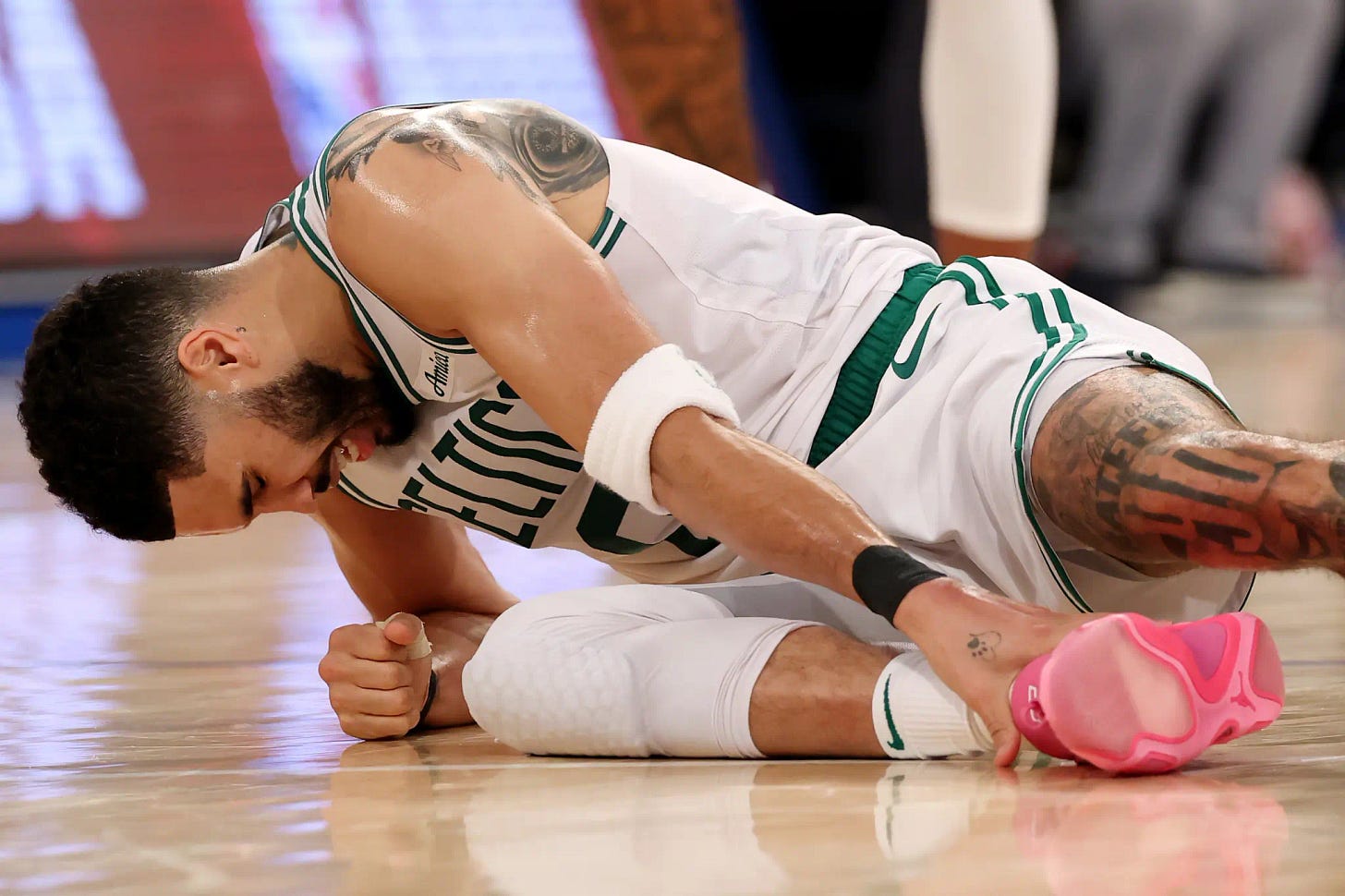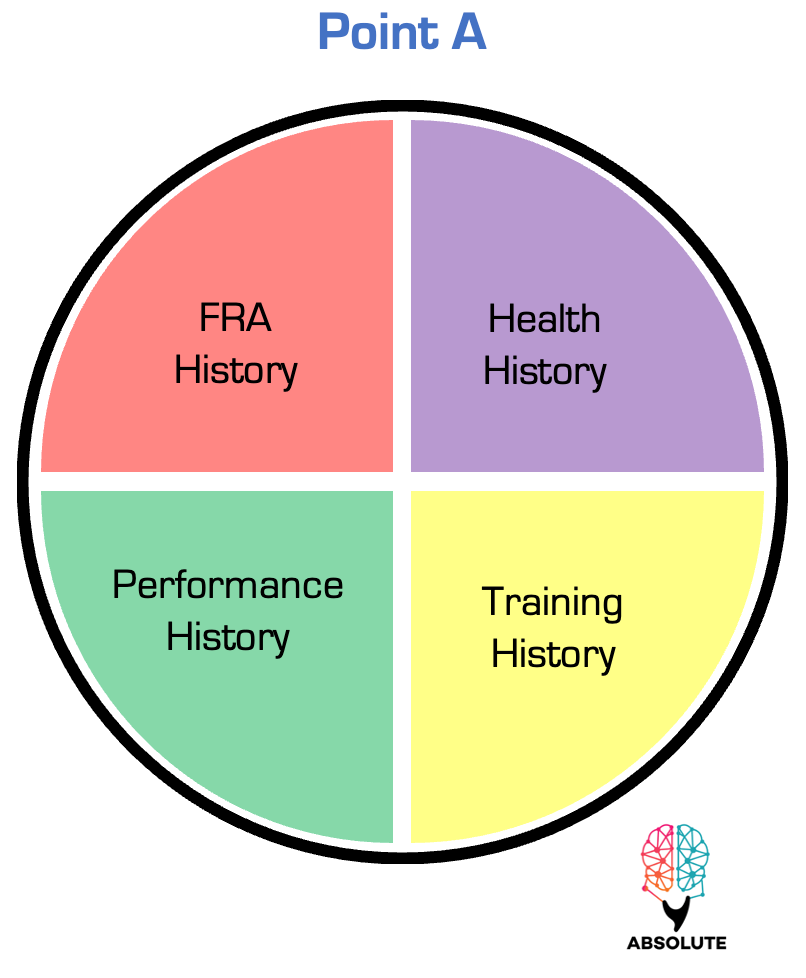The NBA's Achilles Tendon Reactive Strength Problem
This season’s Achilles injury surge in the NBA is not random. It’s feedback that outdated definitions and siloed staffs systems are failing to develop this special strength of Point B.

Reactive Strength: The Unseen Limiting Constraint Behind the NBA’s Injury Surge
Most of high-performance sport still doesn’t see the real problem behind this season’s spike in Achilles tendon ruptures. They see injury. We see more feedback—different day, same problem.
At Absolute, we’ve known for years what this really is: a Reactive Strength Problem—and now the numbers sadly speak for themselves. This NBA season has already seen six Achilles tendon ruptures, an all-time record set in 2025. And the season isn’t over. In fact, we’re in the most physically and psychologically demanding phase of the year: the playoffs—where in a 15-day span, two NBA superstars suffered Achilles tears: Damian Lillard and Jayson Tatum.
And these reactive strength ruptures? They’re not happening in freak accidents or maximal neural outputs. They’re happening under normal sport demands—routine force transmission scenarios. Jayson Tatum’s rupture occurred during a normal change-of-direction—a relative strength output. A tissue eccentric loading-to-length demand that should be managed and transmitted if…the underlying connective tissue network was prepared—but sadly it wasn’t.
Special Strengths: More Important in 2025 Than Anytime Ever
Maybe the Soviets were onto something when they obsessed over Special Strengths? We certainly think so. But we’ve taken that concept further—understanding special strength from the inside out instead of outside in. It’s a much deeper dive, but four our business in high performance in 2025 it’s proven to be a safer one. We have had more than enough feedback to coherently understand the solution to this problem doesn’t live at the surface level, but its deeper—you know inside the athlete at the level of adaptation—specifically the connective tissue architecture.
Viewed through our special strength lens, this isn’t random. It’s a predictable failure of biology—explosions of connective tissue under what should be manageable neural output. And the pattern is becoming louder, clearer, harder to ignore.
We get messages on Instagram after every one of these: “Another reactive strength injury.” Yes—we know and we’re glad more practitioners are seeing it too. We named it years ago. Now the field is catching up.
Steph Curry? Sidelined with a hamstring strain—another reactive strength injury, just with a different name. Years of skill acquisition work, now constrained by a connective tissue network that can’t transmit force when it matters most.
This isn’t a volume problem. It’s not just a loading problem. Wake up, we’re in a new paradigm. This is a paradigm problem.
It Was Concurrently Violent & Explosive
How we see it is we’re living in the aftermath of the neurological training Big Bang. We were there—literally. For years, we walked into a barbell club and watched neurological potential become actualized into reality via the execution of very specific training work. That skin-in-the-game learning enabled us to know that it gets chaotic at the edge of special strength emergence. That actualization of more absolute strength voluntarily coming into reality—it was violent and explosive—get it? Big Bang.
One of the most important things we learned is that the Muscular Strength Deficit only voluntarily emerges into reality under maximal loading. A baptism by loading, you could say. Make sense—Law of Specificity. The Soviets and Bulgarians learned this in much the same way back in 1970s.
Every strength coach who visited and witnessed the nervous system actualize into reality under maximal loading knew—deep within their own neurology—that something fundamental about training had radically shifted. An inflection point. You can’t read about this shit in books. You had to see it. Whatever’s been written doesn’t do it justice. It had a feel to it—one you could only understand by being there and feeling the emergence.
And everyone was welcome. Because Louie—the Godfather, as he was known in the spot of Powerlifting—understood that a conjugate demands collaboration—its nucleus is concurrent. And he extended that collaboration to anyone willing to learn. They traveled from all over the world. What a time to be alive—and a place to be.
But that Big Bang of concurrent Soviet + Bulgarian methods, accommodating resistance, and the Godfather—all colliding in one facility, in the West, went boom and it has created a reverberation we still feel to this day in 2025.
If you never felt it in real life, take our word for it: neurological actualization is violent. It’s explosive. What we’re trying to say is simple: The bang was so fucking big that there’s still a reverberation—we feel it at Absolute and have said it nicely for years. Maybe it’s time to say it more clearly: This neurological boom changed the field of Training Science—the world we now have to function in as strength practitioners. We are now left with the biological bubble…
The reality we live in is that we are left with is a dangerous asymmetry—unconstrained neural network scaling that has outpaced biological adaptation. The bottom up element of reactive strength, connective tissue can’t keep up. Instead of reactive strength rebounding into reversal strength, the Jayson Tatum collapses and announcers and fans watch with confusion thinking: “Was there even an injury?…it looked like nothing.”
Sadly, there was a reactive strength injury. The connective tissue instead of reversing just kept eccentrically lengthening until it ruptured. This is a real problem—with a web of interconnected determinants.
But more importantly: we view this as a solvable problem. One that once we solve—and trust us, we are betting everything we have that we will solve it, that athletes will be enabled to generate higher and higher outputs. Our bet is there is a lot hidden potential and we have a strategy to actualize it.
First things first is we need is a definition that enables us to concurrently treat and train this special strength. We need to redefine reactive strength—which we did years ago...
Redefining Reactive Strength
Solving the reactive strength problem requires a new definition—below is ours:
Treatment & Training Staffs Need to Work Concurrently—Now More Than Ever
This isn’t just an NBA issue—last season, the NFL spent billions on their reactive strength problem without blinking. These reactive strength injuries aren’t isolated events; they’re symptoms of a larger dysfunction across high-performance staffs in sport as one element within that big web of determinants. Just as neurology and biology must be trained concurrently, clinical and performance staffs must work concurrently.
Most staffs are still operating in silos—like a left and right leg walking in opposite directions.
Each leg should be striding in sync toward Point B. But without shared data from Point A—FRA results, tissue tension findings, and neurological output from absolute and speed-strength assessments—there’s no shared and unified strategy to reach it. Instead of tight feedback loops, there are disconnections and isolated loops that amplify dysfunction—like neurology outpacing biology. And when you’re managing reactive strength—the most complex special strength in sport in 2025—disconnection is a very dangerous game. This 2025 season, has had more Achilles tendons exploded than in any season in NBA history. The biological bubble is big—and the feedback is it is only getting bigger.
This is a painful problem. Just look at Jayson Tatum. It cascades: athletes pay the price, organizations pay the price—the Celtics just got eliminated—and staffs pay the price too. But it doesn’t have to be this way.
When reactive strength is redefined as a treatable and trainable special strength, you don’t just amplify performance output—you mitigate the #1 limiting constraint on high performance today. And you begin to deflate the biological bubble before more of them burst.
Retire the Old Definition or Stay Stagnant
This is why we formed Absolute: to say, out loud, that stagnation is the problem in modern sport. And stagnation is a solvable problem. But solving it requires growth. It requires retiring old, incomplete, and inaccurate definitions.
This isn’t 1990. It’s 2025—and we’re living inside a biological bubble.
If you're still using a definition of reactive strength from that era, it's time to retire it. The old definition doesn’t account for the concurrent demands of treatment and training. It doesn’t enable performance staffs to navigate the complexity of managing this special strength. And it clearly isn’t preventing athletes from blowing up connective tissues in routine, non-contact relative strength force transmission scenarios.
We're not here to attack staffs. We're here to work concurrently—in conjugation with them.
Let’s collaborate. Let’s all start moving in the direction of Point B Reactive Strength by retiring the outdated definition—because it’s a limiting constraint for both performance and clinical staffs. It’s just one determinant in a much larger dysfunction, but it’s an easy one to remove—so stop limiting yourself as a practitioner and remove it.









